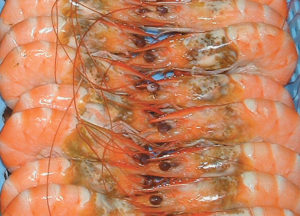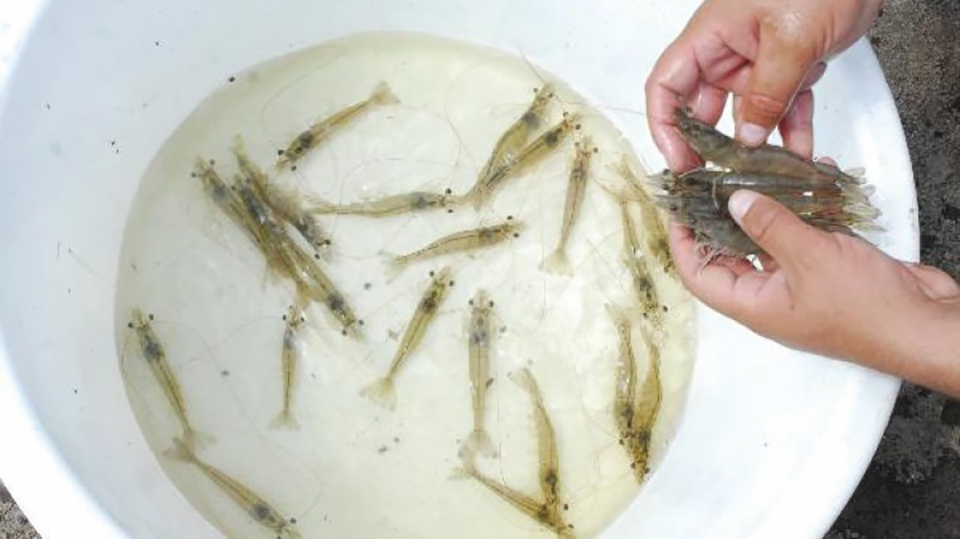Contributing conditions including poor water quality, cyanobacteria, low-quality feeds and inadequate harvest, post-harvest procedures

In recent years, producers of farmed shrimp in various parts of the world have faced a problem with discoloration of their product to be processed as head-on, shell-on for the European cooker markets. Caused by a ruptured or damaged hepatopancreas in the animals, the heads of affected shrimp have red, orange, black, or even green discoloration. Depending on the country, this condition has been called red head, black head, and other terms. Here it will be referred to as ruptured or discolored hepatopancreas or RDHP.
RDHP significantly affects the appearance of shrimp, especially after cooking. In raw shrimp with RDHP, the hepatopancreas is reddish, but after cooking it becomes black. This affects the marketing of these animals, because consumers often will not accept them. The problem is most serious in lighter-colored species like Pacific white shrimp (Litopenaeus vannamei) because of the increased contrast between the bodies and the darker heads.
In recent years, RDHP had been reported incidentally in some Latin American countries, but it now seems to be more prevalent. Further incidents are being reported from other shrimp-farming regions, often involving L. vannamei from Southeast Asia.
The incidence of RDHP seems to relate to conditions, including inadequate water quality in grow-out ponds, the presence of cyanobacteria (blue-green algae), low-quality aquafeeds, and inadequate harvest and postharvest procedures, particularly temperature control.
Cyanobacteria
Grow-out ponds in which bottoms have significant sludge and debris, and/or water exchange is low favor the development of cyanobacteria. The most effective management strategies for cyanobacteria include increasing water exchange or increasing water movement by careful placement of aerators to improve circulation in “dead” zones of ponds, and the use of products that treat the water to control the development of cyanobacteria. Nevertheless, RDHP can occur in new ponds, as well as well-managed ones with adequate water quality.
Stress
Hepatopancreas autolysis could relate to brittleness of the organ’s cell membranes caused by oxidative stress from large levels of free radicals in the host animal when under stressful conditions. During harvest, stressed shrimp increase their respiration rates, and the resulting excessive oxygen levels increase the production of free radicals.
If these radicals are not eliminated by the animal, they attack the unsaturated lipids in membranes. This peroxidation process is more relevant in the hepatopancreas because it is an extremely active organ involved in digestion and synthesis that accumulates significant levels of important lipids highly sensitive to peroxidation. Consequently, it is very important to eliminate or minimize stress factors as much as possible.
The dissolved-oxygen rate in shrimp grow-out systems must be maintained at a minimum level of 3 ppm, but oversaturation must also be avoided. The application of feed with higher levels of antioxidants like vitamins C and E, and carotenoid pigments during the last few weeks before harvest is also recommended.
Adequate chilling
As soon as shrimp die, digestive enzymes in the hepatopancreas start digesting the animals’ flesh. This causes lysis of the hepatopancreas cells and thinning of its outer membrane, which can lead to rupture.
This problem can be controlled by chilling the shrimp immediately after harvest. In most cases, the harvest team treats the shrimp by dipping them in metabisulfite solution baths immediately after removal from ponds, and care must be given to the solution temperature. A thermometer must be used to systematically and accurately measure and control the temperatures in the treatment tanks.
In many countries, shrimp are not treated at the farm but transfered in boxes with ice to processors. This is not efficient, for the ice has mostly a thermal insulation effect. Only the water from melting of the ice actually chills the harvested product. In such situations, it is important to chill the shrimp prior to their transfer in boxes by dipping them in a tank of 1 to 3 degrees-C water for two to three minutes.
Temperature control
It is fundamental to continue to control the condition of the hepatopancreases of shrimp in the processing plant. The most difficult task is to accurately determine the hepatopancreas condition when the shrimp are effectively frozen, which occurs when flesh temperature goes below minus-18 degrees C. Enzymatic reactions that cause flesh deterioration are slowed by low temperature, but only stopped at that point.
For quick-freezing systems or brine freezing, the time to reach minus-18 degrees-C is very short. But in the case of blast freezers, it could take several hours to reach the critical temperature, so it is necessary to estimate the time. This phase is especially important because the temperature of the shrimp can increase again if the temperature in the processing plant rooms during product grading and sorting is not low enough.
Feed quality
It is possible that RDHP problems result from inadequate feed quality. In recent years, shrimp farmers facing RDHP in Latin America reported that switching to a different feed batch during the last weeks prior to harvest seemed to address the problem. Several authors have shown the relevance to the hepatopancreas of quality feed ingredients – particularly fishmeal, fish oil, and meal from wheat, corn, and soy.
During the last decade, Asian shrimp-farming countries improved the quality of black tiger shrimp (Penaeus monodon) and developed economical, high-performance feed products. But when L. vannamei were introduced in these countries, some feed manufacturers switched to lower-quality raw materials because of the known, less-demanding nutritional needs of the species. L. vannamei require lower protein rates than P. monodon, but the quality of raw materials must still be considered.
The fishmeal and oils used in L. vannamei feeds, many of which are locally produced from products and byproducts of traditional fisheries, may not receive proper preservation. Some of these fishmeals and oils have high oxidative rates and low pH values, and may also contain products resulting from lipid peroxidation. They could induce oxidative stress in animals fed these products.
Supply and demand issues could play a role, because in recent months, fishmeal prices have more than doubled. Concurrently, shrimp market prices have remained more or less low and stable. It is not inconceivable that some aquafeed manufacturers may have used lower-quality ingredients to manage their costs.
Mycotoxins
In tropical countries with hot, humid climates, aflatoxins (mycotoxins) can often contaminate aquafeeds. Associated with grain-based ingredients, aflatoxins are very resistant to high temperature and not destroyed during feed manufacturing. These mycotoxins are known to cause hepatopancreasas damage in shrimp, and in some cases could be involved in RDHP issues.
The best prevention is to avoid the use of contaminated raw materials – a critical quality control issue in aqua-feed plants. Use of appropriate antimycotic feed additives is also important.
(Editor’s Note: This article was originally published in the September/October 2006 print edition of the Global Aquaculture Advocate.)
Now that you've reached the end of the article ...
… please consider supporting GSA’s mission to advance responsible seafood practices through education, advocacy and third-party assurances. The Advocate aims to document the evolution of responsible seafood practices and share the expansive knowledge of our vast network of contributors.
By becoming a Global Seafood Alliance member, you’re ensuring that all of the pre-competitive work we do through member benefits, resources and events can continue. Individual membership costs just $50 a year.
Not a GSA member? Join us.
Author
Tagged With
Related Posts

Health & Welfare
A holistic management approach to EMS
Early Mortality Syndrome has devastated farmed shrimp in Asia and Latin America. With better understanding of the pathogen and the development and improvement of novel strategies, shrimp farmers are now able to better manage the disease.

Aquafeeds
A look at phospholipids in aquafeeds
Phospholipids are the major constituents of cell membranes and are vital to the normal function of every cell and organ. The inclusion of phospholipids in aquafeeds ensures increased growth, better survival and stress resistance, and prevention of skeletal deformities of larval and juvenile stages of fish and shellfish species.

Aquafeeds
A look at protease enzymes in crustacean nutrition
Food digestion involves digestive enzymes to break down polymeric macromolecules and facilitate nutrient absorption. Enzyme supplementation in aquafeeds is a major alternative to improve feed quality and nutrient digestibility, gut health, compensate digestive enzymes when needed, and may also improve immune responses.

Health & Welfare
A study of Zoea-2 Syndrome in hatcheries in India, part 1
Indian shrimp hatcheries have experienced larval mortality in the zoea-2 stage, with molt deterioration and resulting in heavy mortality. Authors investigated the problem holistically.


